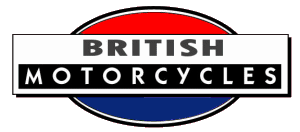


1934 HRD - Cross 500 cc
Roland C. Cross presentó este modelo en el TT de la isla de Man en 1934 aunque los resultados fueron decepcionantes. El cuadro era HRD pero la base del motor era un Rudge TT Replica con cilindro de válvula rotativa Cross con relación de compresión de 10,5 : 1.
En 1937 la revista “Motor Cycling” prueba esta moto y no encuentra puntos que criticar, excepto la salida de escape muy cercana a la pierna del piloto. Además comenta que era fácil de poner en marcha y que el motor tenía la flexibilidad similar a uno de válvulas laterales con una aceleración y velocidad máxima comparable a una 500 OHV super tuneada. Se alcanzó una velocidad de 87 mph / 140 kph en solo 28,5 segundos. Los buenos registros en las distancias de frenado se debían al reconocido sistema de cuatro frenos de Vincent – HRD. La velocidad crucero era de 120 kph a un régimen de 6.000 r.p.m.
Aquí algunas imágenes y los resultados de las pruebas. Como podemos ver el prototipo (GL 1722) aún existe…
1934 Vincent HRD - Cross 500 cc
Roland C. Cross entered this model for the Senior TT at the 1935 Isle of Man but withdrew after problems encountered during practice. The machine was a Vincent HRD Model P which used the original Rudge engine fitted with a Cross rotary valve cylinder running a compression ratio of 10.5: 1.
In 1937 the magazine "Motor Cycling" tested this bike and found no points to criticize, except for the exhaust manifold being very close to the riders's leg. The author also comments that it was easy to start and that the engine had flexibility similar to a side valve engine but with acceleration and maximum speed comparable to a highly tuned 500 OHV. A speed of 87 mph / 140 kph was achieved in just 28.5 seconds. Good records on braking distances were due to Vincent's renowned four-brake system. The cruising speed was 120 kph at 6,000 r.p.m.
The prototype (GL 1722) is housed at the Cross Museum in Bath, and several Cross engines are displayed at Sammy Miller's museum.
The Cross Manufacturing Company developed high-performance piston rings which were used in the Cross Rotary, and this process was applied to other products, particularly in aviation. Cross components have been employed in the engines used on the Concorde, in the A320 Airbus and in submarines.
Motor de válvula rotativa Cross
Roland C. Cross desarrolló un revolucionario sistema de válvula rotativa transversal que controlaba la admisión y el escape simultáneamente, y que tenía la forma de un tubo cilíndrico. Dentro de este tubo había un tabique o pared divisoria que separaba la admisión del escape. Dos ventanas laterales en la válvula permitían vincular la admisión y el escape con la cámara de combustión, mientras que los extremos de la válvula se vinculaban con el carburador y el caño de escape. El sistema eliminaba el movimiento de vaivén de un tren de válvulas convencional (válvulas, varillas de empuje y balancines) y teóricamente permitía lograr un alto rendimiento específico debido a que los valores de compresión y régimen de vueltas eran mayores que en los motores de válvulas convencionales.
Cross trabajó en su sistema desde 1920 (la primera patente es de 1922) hasta 1945, y fue el principal competidor de Aspin dentro de la industria británica de motocicletas. Mientras que Aspin se relacionó con Norton y Velocette, Cross firmó una alianza con HRD para el desarrollo de las motos de carreras, así como también construyó unos prototipos con base Rudge, JAP y BSA.
Los mayores problemas eran de lubricación en la válvula rotativa y de sellado (que provocaba el mojado de la bujía con aceite pulverizado desde la válvula rotativa) hasta 1934 cuando Cross rediseñó el alojamiento para la válvula haciéndolo en dos piezas en forma de puente que se mantenían presionados contra ella por medio de un pórtico elástico autoajustable.
Pero el sueño terminó en 1935 ya que, como los prototipos de competición de Aspin, los prototipos de HRD fracasaron estrepitosamente en el TT de la Isla de Man. Una moto resultó ser demasiado lenta para clasificar, mientras que la otra abandonó después de dos vueltas con "problemas de bujía" que bien puede ser debido a los problemas con el aceitado en la bujía antes mencionado.
Cross desarrolló un proceso para la fabricación de aros de pistón de alto rendimiento a partir de alambre para su motor de válvula rotativa, por eso fundó la compañía que todavía existe. http://www.crossmanufacturing.com/history_of_cross.html
En la década de 1950, Laurie Bond (creador del triciclo Bond Three Wheeler) propone a Norton un sistema de válvula fuertemente inspirado en el sistema de Cross. El ingeniero del proyecto Joe Craig desarrolla una tapa de cilindro de competición para la Norton Manx de 1960 después de dos años y medio de trabajo.
Con problemas de sellado y desgaste, este motor no era más potente que el original de válvulas convencionales, y dadas las dificultades para conseguir más dinero para investigación y desarrollo, el proyecto fue abandonado.
Roland C. Cross developed a revolutionary transverse rotary valve system that controlled intake and exhaust simultaneously, and was shaped like a cylindrical tube. Inside this tube was a partition or dividing wall that separated the intake from the exhaust. Two side windows on the valve allowed linking the intake and exhaust with the combustion chamber, while the ends of the valve were linked to the carburetor and the exhaust pipe. The system eliminated the reciprocating movement of a conventional valve train (valves, push rods and rocker arms) and theoretically allowed higher performance because the compression and rpm were higher than in conventional poppet valve engines.
Cross worked on his system from 1920 (the first patent is from 1922) until 1945, and was Aspin's main competitor in the British motorcycle industry. While Aspin was involved with Norton and Velocette, Cross signed an alliance with HRD for the development of racing machines, and also built prototypes based on Rudge, JAP and BSA.
The biggest problems were lubrication and sealing of the rotary valve - the spark plug suffered from wetting by atomised oil - until 1934 when Cross redesigned the valve housing using two bridge-shaped parts that were maintained in position by means of a self-adjusting mechanism.
The dream ended in 1935 because, like the Aspin competition prototypes, the HRD prototypes failed dismally at the Isle of Man TT. One bike proved to be too slow to qualify, while the other retired after two laps with "spark plug problems" which may well be due to the problems mentioned above.
Cross developed a process for manufacturing high-performance piston rings from wire for its rotary valve engine; the company he founded to market the rings still exists.
In the 1950s, Laurie Bond (creator of the Bond three wheeler) proposed to Norton a valve system strongly inspired by the Cross system. Project engineer Joe Craig spent two and a half years developing a competition cylinder head for the 1960 Manx Norton. With problems of sealing and wear, this engine was proved no more powerful than the conventional poppet valve model; further finance for research and development was not available and the project was abandoned.
Sources: Sergio Scalerandi, crossmanufacturing.com
If you have further information or a query related to this page, please contact us